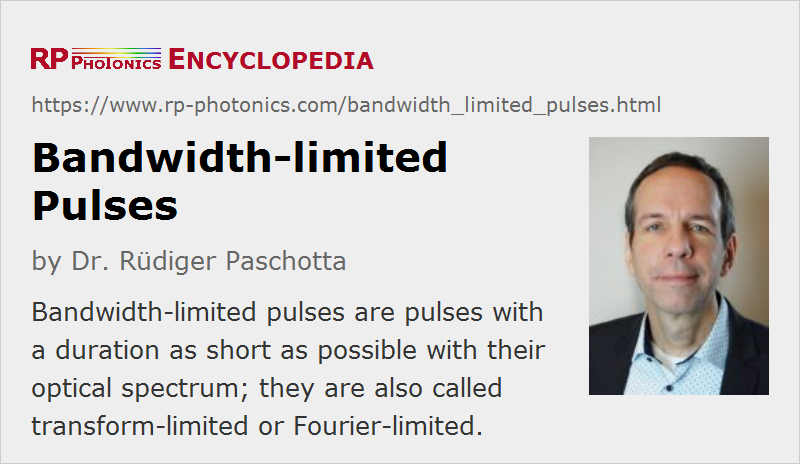Bandwidth-limited Pulses
Definition: pulses with a duration as short as possible with their optical spectrum
Alternative term: transform-limited pulses
German: bandbreitebegrenzte Pulse
Author: Dr. Rüdiger Paschotta
Cite the article using its DOI: https://doi.org/10.61835/zft
Get citation code: Endnote (RIS) BibTex plain textHTML
A bandwidth-limited light pulse (or transform-limited pulse) is a pulse which is as short as its spectral bandwidth permits. In other words, its time–bandwidth product is as small as possible for a given temporal or spectral shape For example, the minimum time–bandwidth product of sech2-shaped pulses (calculated with the full width at half-maximum both in time and frequency domain) is 0.315, which implies that bandwidth-limited sech2 pulses with a duration of 100 fs must have a bandwidth of 3.15 THz.
Note that the considered spectral bandwidth is related to the Fourier transform of the electric field. That bandwidth is necessarily large when the pulses are very short; that is due to the basic mathematical properties of Fourier transforms [1], i.e., not related to any physical processes e.g. of the used pulse generation mechanism.
A slightly different definition for a bandwidth-limited pulse is that its peak power is as high as the optical bandwidth allows (for a given pulse energy). This is equivalent to the pulse having a flat spectral phase, but does not always precisely lead to the shortest possible pulse duration in terms of full width at half maximum.

If an initially transform-limited pulse propagates through a medium, its time–bandwidth product can increase due to the influences of chromatic dispersion or nonlinearities. For example, the influence of dispersion can temporally stretch the pulse while leaving its spectral width constant. This is associated with a chirp. This chirp can later be removed by dispersive pulse compression, restoring the original pulse duration.
Many mode-locked lasers, particularly soliton mode-locked solid-state lasers, but also some mode-locked diode lasers, can generate nearly bandwidth-limited pulses. This feature is very desirable e.g. in optical fiber communications, as it minimizes dispersive temporal broadening.
More to Learn
Encyclopedia articles:
Blog articles:
Bibliography
| [1] | R. Paschotta, Photonics Spotlight article “Understanding Fourier Spectra” |
Questions and Comments from Users
2023-03-10
Other sites including Wikipedia (falsely) claim that a bandwidth limited pulse has a flat phase. Is there another convention, since you say it is not necessarily the shortest pulse with flat phase, or is that case just a rare or extreme case where one is not the other?
The author's answer:
If you take my definition of bandwidth-limited pulses, you can construct some pulse shapes where a slightly non-flat phase leads to a slightly shorter pulse, and only that pulse should be called bandwidth-limited. But usually these are small differences, and note that “bandwidth-limited” is often not meant to be a precise mathematically defined property.
Here you can submit questions and comments. As far as they get accepted by the author, they will appear above this paragraph together with the author’s answer. The author will decide on acceptance based on certain criteria. Essentially, the issue must be of sufficiently broad interest.
Please do not enter personal data here; we would otherwise delete it soon. (See also our privacy declaration.) If you wish to receive personal feedback or consultancy from the author, please contact him, e.g. via e-mail.
By submitting the information, you give your consent to the potential publication of your inputs on our website according to our rules. (If you later retract your consent, we will delete those inputs.) As your inputs are first reviewed by the author, they may be published with some delay.

 light pulses
light pulses


















2020-11-10
What happens when you have a very narrow linewidth laser beam and you shut on/off (e.g. by a mechanical shutter) this beam to get below the time–bandwidth product?
The author's answer:
You cannot get below the time–bandwidth limit with optical switching, since the switching is a kind of modulation which increases the width of the optical spectrum – even if the instantaneous frequency of the optical field stays constant.